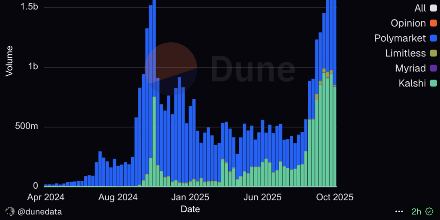Polygon’s Institutional-Centric Strategy with USDT0 and XAUt0: A New Era for Blockchain Infrastructure
- Polygon deploys USDT0 and XAUt0 on its blockchain, leveraging Bhilai Hardfork and AggLayer to enhance scalability and cross-chain liquidity for institutional markets. - The 2025 GENIUS Act and SEC regulations provide compliance frameworks, enabling institutions to adopt asset-backed stablecoins like XAUt0 for lending and hedging. - USDT0's $1.6B market cap and XAUt0's gold-backed liquidity demonstrate growing demand for institutional-grade blockchain solutions with regulatory clarity. - Polygon's infrast
Blockchain technology has long been positioned as a disruptor in finance, but its true potential for institutional-grade infrastructure has only recently begun to crystallize. Polygon’s strategic deployment of USDT0 and XAUt0 on its blockchain represents a pivotal step in this evolution, merging cross-chain liquidity with robust compliance and scalability. By leveraging innovations like AggLayer and the Bhilai Hardfork, Polygon is not just accommodating institutional demand—it is redefining the architecture of digital asset infrastructure for a multichain future.
The Institutional Imperative: Scalability and Compliance
Polygon’s infrastructure upgrades, particularly the Bhilai Hardfork and AggLayer, address two critical pain points for institutional adoption: scalability and finality. The Bhilai Hardfork increased the network’s throughput to over 1,000 transactions per second (TPS) by raising the block gas limit from 30M to 45M, while also enabling gasless transactions via EIP-7702 [1]. This is a game-changer for high-volume stablecoin activity, as USDT0 and XAUt0 now facilitate $3 billion+ in stablecoin volume on Polygon [3].
AggLayer, a cross-chain settlement layer, further enhances this by connecting liquidity across blockchains with pessimistic proof mechanisms, ensuring cryptographic security and preventing over-withdrawals [4]. For institutions, this means a unified bridge that reduces counterparty risk while enabling seamless asset transfers. The integration of USDT0 and XAUt0 into this framework eliminates the need for bridges or wrapped tokens, slashing costs and complexity [3].
Regulatory Clarity and Institutional Trust
The 2025 GENIUS Act, the first federal legislation on digital assets, has provided a regulatory backbone for institutional-grade tokens like USDT0 and XAUt0. By mandating one-to-one reserves of US dollars and short-term Treasuries for payment stablecoins, the Act ensures transparency and stability [3]. This aligns with Tether’s design for USDT0, which maintains the same contract address as its bridged predecessor, ensuring continuity for protocols and users [4].
Meanwhile, the SEC’s Project Crypto initiative has clarified rules for liquid staking and custody, enabling banks to securely hold digital assets for institutional clients [5]. These developments have transformed USDT0 and XAUt0 into compliant, institutional-grade assets. For example, XAUt0’s gold-backed nature allows institutions to collateralize gold in lending and hedging strategies, expanding their financial toolkits [2].
Market Impact and Cross-Chain Liquidity
The market response to USDT0 and XAUt0 has been swift. USDT0’s market capitalization surged to $1.6 billion within two months of its January 2025 launch, while XAUt0 reached $2.5 million [2]. This growth reflects demand for asset-backed liquidity solutions and underscores Tether’s role in shaping omnichain finance.
Polygon’s existing infrastructure—supporting $1.3 billion in USDT liquidity and 6 million active wallets—positions it as a natural hub for institutional adoption [3]. The integration of XAUt0, in particular, introduces gold-backed liquidity into DeFi protocols, enabling novel use cases like gold-backed stablecoin lending [4].
Conclusion: A Blueprint for Institutional Blockchain
Polygon’s strategy with USDT0 and XAUt0 exemplifies how blockchain can meet institutional demands for scalability, compliance, and cross-chain efficiency. By combining infrastructure upgrades with regulatory alignment, Polygon is not just supporting institutional finance—it is building the rails for a new era of digital asset infrastructure. For investors, this represents a compelling case for blockchain’s role in institutional-grade markets, where innovation and regulation converge to unlock value.
Source:
[1] Polygon Supports 1000 TPS with Bhilai Hardfork
[2] The Strategic Expansion of USDT0 and XAUt0 on Polygon
[3] USDT0 and XAUt0 Now Available on Polygon Blockchain
[4] Agglayer
[5] U.S. Regulatory Shifts and the Path to Institutional Crypto Adoption
Disclaimer: The content of this article solely reflects the author's opinion and does not represent the platform in any capacity. This article is not intended to serve as a reference for making investment decisions.
You may also like
OracleX Global Public Beta: Restructuring Prediction Market Incentive Mechanisms with "Proof of Behavior Contribution"
OracleX is a decentralized prediction platform based on the POC protocol. It addresses pain points in the prediction market through a dual-token model and a contribution reward mechanism, aiming to build a collective intelligence decision-making ecosystem. Summary generated by Mars AI The content of this summary is produced by the Mars AI model, and its accuracy and completeness are still being iteratively improved.

Bitcoin is not "digital gold"—it is the global base currency of the AI era
The article refutes the argument that bitcoin will be replaced, highlighting bitcoin's unique value as a protocol layer, including its network effects, immutability, and potential as a global settlement layer. It also explores new opportunities for bitcoin in the AI era. Summary generated by Mars AI. This summary was produced by the Mars AI model, and the accuracy and completeness of its content are still being iteratively improved.

Bitcoin 2022 bear market correlation hits 98% as ETFs add $220M

Fed rate-cut bets surge: Can Bitcoin finally break $91K to go higher?
